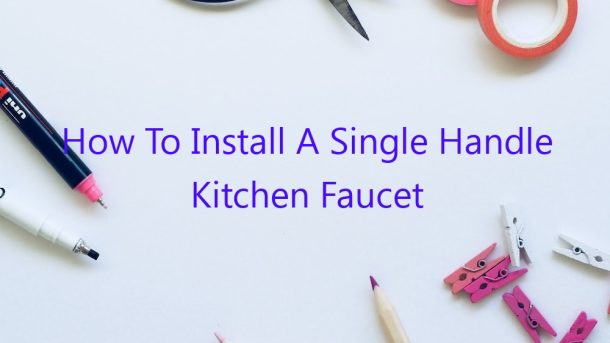Installing a kitchen faucet is a relatively easy task that can be completed in a few hours. This guide will show you how to install a single handle kitchen faucet with a sprayer.
Tools and materials needed:
-Adjustable wrench
-Channel locks
-Crescent wrench
-Pencil
-Tape measure
-Screwdriver
-Silicone sealant
-New kitchen faucet
-Sprayer hose
-Washers
-Faucet mounting nuts
1. Shut off the water supply to the faucet by turning off the valve under the sink.
2. Open the faucet to relieve the pressure in the lines.
3. Disconnect the supply lines from the faucet.
4. Remove the old faucet by unscrewing the mounting nuts.
5. If the old faucet was installed with plumber’s putty, remove it by using a putty knife.
6. Clean the area around the sink hole with a rag.
7. Apply a thin layer of silicone sealant to the underside of the faucet.
8. Insert the faucet into the hole and tighten the mounting nuts.
9. Reconnect the supply lines to the faucet and turn on the water supply.
10. Test the faucet for leaks.
11. Attach the sprayer hose to the faucet.
12. Adjust the water pressure to your liking.
13. Enjoy your new kitchen faucet!
Contents [hide]
How do you install a single handle kitchen faucet with side sprayer?
Installing a kitchen faucet is a fairly simple process, and can be completed in about an hour. This guide will show you how to install a single handle kitchen faucet with a side sprayer.
1. Shut off the water supply.
2. Disconnect the old faucet.
3. Remove the old faucet and the supply lines.
4. Clean the area where the new faucet will be installed.
5. Install the new faucet.
6. Reconnect the supply lines.
7. Turn on the water supply and test the faucet.
Shutting off the water supply
Before you can begin installing the new faucet, you’ll need to shut off the water supply. The water supply is typically located under the kitchen sink, and is often marked with a red or blue handle.
Disconnecting the old faucet
To disconnect the old faucet, you’ll need to loosen the screws that hold it in place. These screws can be found at the base of the faucet or on the side of the sink. Once the screws are loose, you can pull the faucet off the sink.
Removing the old faucet and the supply lines
Once the old faucet is disconnected, you’ll need to remove the supply lines. The supply lines are typically held in place with compression fittings. To remove the supply lines, you’ll need to loosen the fitting with a pair of pliers. Once the fittings are loose, you can pull the supply lines out of the faucet and the sink.
Once the old faucet and the supply lines are removed, you can clean the area where the new faucet will be installed.
Installing the new faucet
To install the new faucet, you’ll need to first remove the aerator from the end of the faucet. The aerator is the part of the faucet that helps to reduce water flow. Once the aerator is removed, you can insert the faucet into the hole at the base of the sink.
Once the faucet is in place, you can reconnect the supply lines. To do this, you’ll need to loosen the fittings on the supply lines. Once the fittings are loose, you can push the supply lines onto the faucet and the sink.
Once the supply lines are attached, you can tighten the fittings with a pair of pliers.
Turning on the water supply and testing the faucet
Once the faucet is installed, you can turn on the water supply and test the faucet. To do this, you’ll need to open the faucet. Once the faucet is open, you can test the water pressure by running the water for a few minutes.
If the water pressure is low, you can adjust the water pressure by turning the water supply valve. This valve is typically located under the kitchen sink and is often marked with a red or blue handle.
How do you install a kitchen faucet sprayer attachment?
Installing a kitchen faucet sprayer attachment is a project that most homeowners can do on their own. The first step is to remove the old faucet sprayer, if there is one. This can be done by unscrewing the sprayer head from the hose. The new sprayer attachment can then be attached to the hose in the same way.
Next, the faucet handle must be removed. This is usually done by unscrewing it from the valve. The valve can then be unscrewed from the pipe. The new sprayer attachment can be attached to the pipe in the same way.
The faucet handle and valve can then be re-attached in the reverse order. Be sure to tighten all the screws securely.
The final step is to re-attach the sprayer head to the hose. This can be done by screwing it on tightly.
Now the kitchen faucet sprayer attachment is installed and ready to use.
How do you connect a sprayer hose to a faucet?
When you want to connect a sprayer hose to a faucet, you’ll need to find an adapter. This adapter will have a male end that will fit into the faucet, and a female end that will hold the sprayer hose. Once you have the adapter, it’s just a matter of connecting the hose to the adapter and tightening the connector.
How do you install the sprayer to the faucet?
Installing a sprayer to your faucet is a simple process that can be completed in a few minutes. All you need is a screwdriver and a wrench.
First, remove the aerator from the end of the faucet. This can be done by unscrewing it with a screwdriver.
Next, use a wrench to loosen the coupling nut that holds the faucet in place. This nut is located at the base of the faucet.
Once the coupling nut is loose, pull the faucet straight up and off of the sink.
Now you can install the sprayer. First, thread the connector nut onto the end of the sprayer hose. Then, twist the sprayer onto the threads at the end of the faucet.
Finally, reattach the aerator to the end of the faucet and tighten it in place with a screwdriver.
How do you install a single handle kitchen faucet?
Installing a single handle kitchen faucet may seem daunting, but with the proper tools and instructions, it can be a relatively easy task. This guide will walk you through the installation process step-by-step.
1. Turn off the water supply to the kitchen faucet. There should be a shutoff valve located under the sink.
2. Remove the old faucet. This can be done by unscrewing the mounting nuts or by using a wrench to break the seal.
3. Install the new faucet. First, attach the mounting nuts (or insert the seal if using a wrench). Next, connect the water supply lines. Be sure to use Teflon tape or a sealant to prevent leaks.
4. Turn on the water supply and check for leaks. If everything is installed correctly, there should be no leaks.
5. Enjoy your new kitchen faucet!
How do you install a Moen kitchen faucet sprayer?
Installing a Moen kitchen faucet sprayer is a relatively easy process, and can be completed in a matter of minutes. Before beginning, make sure that you have the necessary tools and parts on hand. These include:
-A Phillips-head screwdriver
-Channel-locks or pliers
-A bucket or container to catch water
Once you have the necessary tools and parts, follow these steps to install your Moen kitchen faucet sprayer:
1. Shut off the water supply to the faucet.
2. Disconnect the water supply lines from the faucet.
3. Remove the faucet handle and the escutcheon (the decorative cover that goes around the faucet handle).
4. Unscrew and remove the faucet nut.
5. Remove the faucet aerator.
6. Remove the faucet sprayer.
7. Install the new sprayer.
8. Reconnect the water supply lines.
9. Reattach the faucet handle and escutcheon.
10. Turn on the water and check for leaks.
If you have any questions or concerns, please contact the Moen customer service department.
Can you add a sprayer to an existing kitchen faucet?
When it comes to kitchen tasks like washing dishes or cleaning vegetables, most people would prefer to use a sprayer over a traditional faucet. This is why adding a sprayer to an existing kitchen faucet can be so helpful. It can make these tasks much easier and faster.
If you’re thinking about adding a sprayer to your kitchen faucet, there are a few things you need to know. First, not all kitchen faucets have a spot where you can add a sprayer. You’ll need to check to see if your faucet has a detachable sprayer head. If it does, you’re in luck – adding a sprayer is a breeze.
If your faucet doesn’t have a detachable sprayer head, don’t worry. You can still add a sprayer by using a diverter. A diverter is a small device that attaches to your kitchen faucet and allows you to switch between a traditional faucet stream and a sprayer stream.
Adding a sprayer to your kitchen faucet can be a great way to make your tasks easier. If you’re not sure if your faucet has a spot for a sprayer, or if you need a diverter, be sure to consult a plumbing professional.




